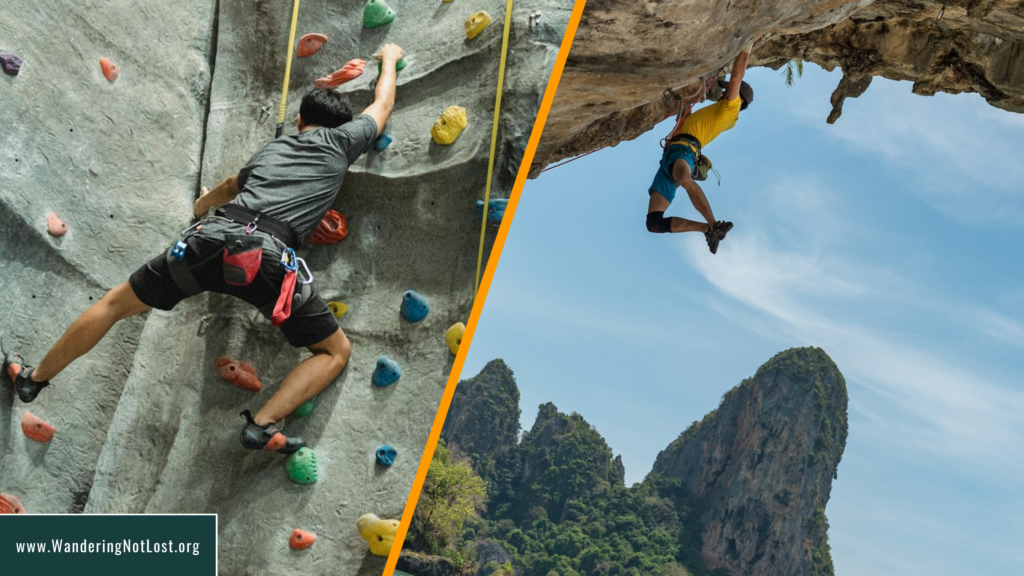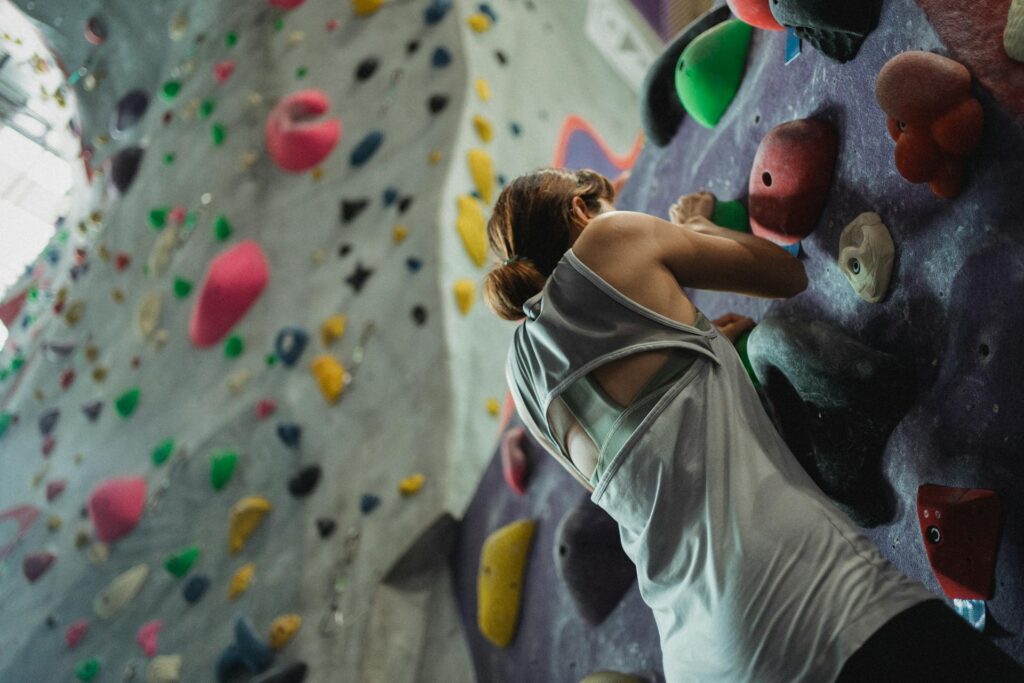Is Bouldering Harder Than Rock Climbing?
Ready to take a fascinating trip into the world of climbing?
The argument between rock climbing and bouldering will excite climbers of all skill levels, from beginners searching for an adrenaline rush to seasoned pros seeking their next challenge.
Bouldering and rock climbing are two very different vertical experiences, each with its appeal and set of difficulties. Which, though, is the harder? The answer is not simple. That mostly relies on individual tastes, abilities both mentally and physically, and particular climbing locations.
We’ll go in-depth on the differences between bouldering and rock climbing in this blog post, as well as the age-old query of whether bouldering is harder than rock climbing.
Understanding Bouldering and Rock Climbing
Overview of the Activities
Both bouldering and rock climbing are exhilarating forms of climbing but differ significantly. Bouldering is climbing on smaller rock formations or artificial walls without the use of ropes, typically at heights of 15-20 feet. Rock climbing, on the other hand, involves scaling taller cliffs or walls with the aid of ropes and other protective gear.
Importance of Comparing the Two
Understanding the distinctions and similarities between bouldering and rock climbing can help aspiring climbers choose the path that aligns with their interests and abilities. It also sheds light on the unique challenges and rewards each discipline offers.
What is Bouldering?

Basics of Bouldering
Bouldering is an intense form of climbing that emphasizes short but challenging routes known as “problems.” Climbers tackle these problems without ropes, relying on crash pads for safety. This activity typically requires a combination of power, precision, and creativity.
Bouldering Techniques
Mastering bouldering involves a variety of techniques. Climbers often use dynamic moves, like jumps and swings, and static techniques, where balance and precise foot placement are crucial. The ability to solve problems—finding the best way to complete a climb—is a critical aspect of bouldering.
Bouldering Grading Systems
Bouldering problems are graded based on difficulty. The V Scale, used predominantly in the United States, ranges from V0 (easiest) to V17 (extremely difficult). The Font Scale, originating from Fontainebleau, France, also rates climbs from easy to exceptionally challenging (e.g., 3 to 8C+).
What is Rock Climbing?

Basics of Rock Climbing
Rock climbing generally refers to scaling vertical or near-vertical surfaces using ropes and protective gear. It encompasses various styles, each with unique techniques and gear requirements.
Types of Rock Climbing
- Sport Climbing: Involves pre-placed anchors for protection. Climbers use quickdraws to clip their ropes into these anchors.
- Traditional (Trad) Climbing: Climbers place their protective gear (like cams and nuts) as they ascend.
- Free Climbing: This involves climbing without any artificial aids for progress, although safety gear is used to protect against falls.
Rock Climbing Grading Systems
The difficulty of rock climbing routes is graded using different systems. The Yosemite Decimal System (YDS) is common in North America, with grades like 5.7 (easy) to 5.15 (extremely difficult). The French Scale, used internationally, ranges from 5a (easier) to 9b+ (hardest).
Comparing Difficulty: Bouldering vs. Rock Climbing

Now that we have a solid understanding of bouldering and rock climbing let’s dive into the heart of the matter – which one is harder? The answer to this question isn’t as straightforward as it may seem. Both bouldering and rock climbing present unique challenges and require different skill sets, making it difficult to declare one as definitively harder than the other.
Let’s break it down further to get a clearer picture of the differences between bouldering and rock climbing in terms of difficulty.
Physical Demands
Both bouldering and rock climbing require strength, flexibility, and stamina to overcome obstacles and reach the top. However, the specific physical demands differ between the two disciplines.
Bouldering: Short, explosive movements that demand maximum power and dynamic strength. Climbers must execute precise footwork and handholds to navigate tricky sequences and solve complex problems.
Rock Climbing: Longer, sustained efforts that test endurance and resilience. Climbers must maintain focus and control while navigating vertical terrain, managing rope systems, and conserving energy for the entire route.
Strength and Power
When it comes to raw strength and power, bouldering often takes the spotlight. Bouldering problems are characterized by short, intense moves that demand a high level of finger strength, upper body power, and core stability. Bouldering routes are often referred to as “problems” for a reason – they require climbers to solve intricate movement puzzles using sheer strength and explosiveness.
On the other hand, rock climbing places a greater emphasis on endurance and stamina. Climbers tackling longer routes need to sustain their energy over an extended period, relying on a combination of strength, technique, and mental resilience to reach the top. Endurance training plays a crucial role in preparing for the demands of rock climbing, making it a challenging aspect of the sport.
Technical Skills
In terms of technical skills, both bouldering and rock climbing require a high degree of precision and finesse. Bouldering necessitates intricate footwork, dynamic movement, and precise body positioning to conquer difficult problems. Climbers must hone their ability to read routes, anticipate holds, and execute complex sequences with accuracy and control.
On the other hand, rock climbing introduces additional technical elements such as rope management, belaying techniques, and route finding. Climbers must master the art of tying knots, setting anchors, and communicating effectively with their climbing partners to ensure a safe and successful ascent. Technical proficiency is paramount in rock climbing, where small mistakes can have serious consequences.
Mental Challenges
Beyond the physical and technical aspects, both bouldering and rock climbing present significant mental challenges. In bouldering, climbers must contend with the pressure of executing precise moves under high-stress conditions. The intense focus required to solve bouldering problems can be mentally draining, testing the climbers’ resilience and problem-solving skills.
Rock climbing introduces a different set of mental hurdles, including fear of falling, mental fatigue, and self-doubt. Climbers navigating long, exposed routes must manage their emotions, stay calm under pressure, and push through moments of uncertainty. Overcoming the mental barriers in rock climbing is often as challenging as conquering the physical cruxes.
Pros and Cons of Bouldering and Rock Climbing
Bouldering

Pros:
- Offers a high-intensity workout that targets specific muscle groups and improves overall strength.
- Provides instant gratification with shorter, more accessible climbing challenges that can be completed in a single session.
- Fosters a strong sense of community and camaraderie among boulderers, who often gather at climbing gyms and outdoor bouldering areas.
Cons:
- Carries a higher risk of injury due to falls from shorter heights and the impact of dynamic movements on joints and tendons.
- Requires specialized crash pads and spotters for safety, which may not always be available in outdoor bouldering areas.
- Limits climbers to shorter and less varied climbing experiences compared to rock climbing.
Rock Climbing

Pros:
- Offers a diverse range of climbing experiences, from multi-pitch trad climbs to challenging sports routes and alpine ascents.
- Promotes a deeper connection to nature and the outdoors, allowing climbers to explore stunning landscapes and remote wilderness areas.
- Provides opportunities for long-term skill progression and personal growth as climbers tackle increasingly difficult climbs and push their limits.
Cons:
- Involves a steeper learning curve and greater reliance on technical knowledge, equipment, and safety protocols.
- Requires a higher level of commitment and dedication to master advanced climbing techniques and tackle complex routes.
- Can be intimidating for beginners due to the perceived risks associated with climbing at height and the need for precise rope handling.
The Debate: Is Bouldering Harder Than Rock Climbing?

Perspectives from Bouldering Enthusiasts
Bouldering enthusiasts argue that the discipline is harder due to the intensity and complexity of individual problems. Each boulder problem is a condensed test of strength, technique, and mental agility, often with no room for error. The requirement for quick problem-solving and the physical toll of repeated attempts can make bouldering feel more challenging.
Perspectives from Rock Climbers
Rock climbers often highlight the sustained endurance and mental fortitude required for longer routes as key challenges. The ability to plan and execute climbs that might take hours, deal with exposure and height, and manage the technical aspects of rope work add layers of difficulty that boulderers don’t face.
Situational Factors Influencing Difficulty
Location and Environment
The environment plays a significant role in determining the difficulty of both bouldering and rock climbing. Indoor bouldering gyms offer controlled conditions, while outdoor bouldering adds variables like rock type, weather, and access issues. Similarly, indoor rock climbing allows for structured training, whereas outdoor climbing involves natural features and unpredictability.
Personal Preferences and Goals
Ultimately, the question of whether bouldering is harder than rock climbing is subjective and depends on individual preferences and goals. Some climbers may find the explosive, high-intensity nature of bouldering more challenging, while others thrive on the endurance-testing aspects of rock climbing. The beauty of both sports lies in their diversity and the ability to cater to a wide range of interests and abilities.
Considerations for Choosing: Bouldering vs. Rock Climbing
When deciding between bouldering and rock climbing, consider the following factors to determine which might be the better fit for you:
- Physical Attributes: Are you more inclined towards explosive power or endurance capabilities?
- Mental Resilience: How do you cope with high-stress situations and mental challenges?
- Social Interaction: Do you prefer climbing in a group or tackling challenges solo?
- Time Commitment: How much time are you willing to dedicate to training and climbing?
Conclusion: Embracing the Challenges
In conclusion, the debate over whether bouldering is harder than rock climbing is not a matter of absolutes but rather a reflection of the diverse nature of both sports. Bouldering and rock climbing each offer their unique sets of challenges, rewards, and growth opportunities. Whether you’re drawn to the explosive power of bouldering or the endurance-testing nature of rock climbing, both sports have something valuable to offer to climbers of all levels.
So, the next time you find yourself pondering over the differences between bouldering and rock climbing, remember that the true essence of climbing lies in embracing the challenges, pushing your limits, and enjoying the journey toward reaching new heights – both on the wall and within yourself. Happy climbing!
Let’s lace up our climbing shoes, chalk our hands, and embark on the thrilling adventure of bouldering and rock climbing, one move at a time. The vertical world awaits, ready to test our strength, hone our skills, and inspire us to overcome obstacles, both physical and mental. Are you ready to rise to the occasion and discover the joy of climbing? The choice is yours – boulder or rock, climb on!
Frequently Asked Questions
For more information on traveling and destination recommendations, check out my other articles on WanderingNotLost.org
Wanderingnotlost.org is a participant in the Amazon Services LLC Associates Program, an affiliate advertising program designed to provide a means for website owners to earn advertising fees by advertising and linking to amazon(.com, .co.uk, .ca etc) and any other website that may be affiliated with Amazon Service LLC Associates Program.As an Amazon Associate, I earn from qualifying purchases

